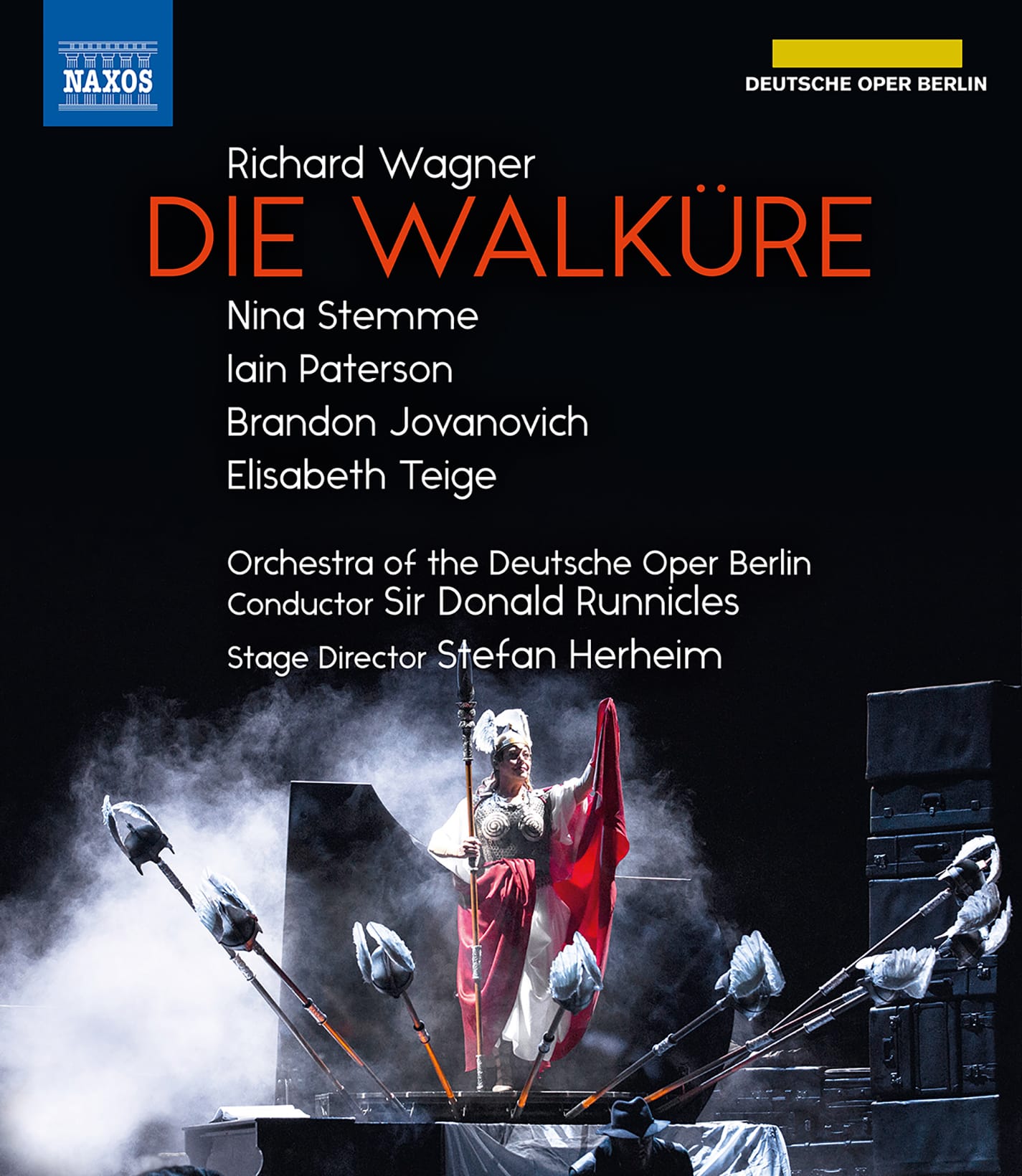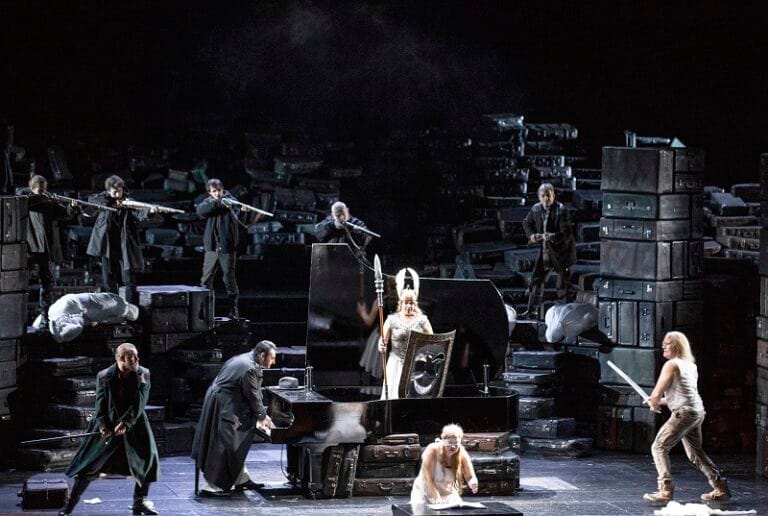Herheim's Walküre from Berlin
Runnicles is a brilliant Wagner conductor, revealing myriad details from his devoted players

Ladies first: so it was at the Deutsche Oper, when Die Walküre (which refers to Brünnhilde, of course) was the first part of Stefan Herheim's new Ring cycle to be performed; Das Rheingold followed on a couple of months later for the first stagers (the cycle was later performed in sequence).
Herheim's Ring succeeds Götz Friedrich's iconic staging in Berlin, anchored at the Deutsche Oper. There are striking images aplenty, not least at the opening, a concert grand piano in a stark, dark setting with a sword protruding from its keyboard. Siegmund and Sieglinde are in modern dress; the walls are made out of suitcases, which in Rheingold had represented another aspect of the giants Fasolt and Fafner, and which are also linked with refugees seen in that preludial evening. As we have seen in the two previous Classical Explorer posts featuring staging by this director (La Bohème, Amahl and the Night Visitors and Die Meistersinger von Nürnberg), Herheim can certainly add twists. Here we have a fourth character in the first act, in addition to Siegmund, Sieglinde and Hunding: a boy, the son of Hunting and Sieglinde, who listens intently to Siegmund's tales and who also furnishes Siegmund with a blade (a sort of proto-Nothung?).
Here's the trailer:
When it comes to “Winterstürme,” a tree grows out the piano. When Siegmund finally extricates the sword Nothing (from the piano itself), Sieglinde slits the boy's throat. This act is all about family and family transgressions, after all.
The lighting (Ulrich Niepel) the supports the set design (Silke Bauer and Stefan Herheim himself), which is predominantly dark. When Siegmind extricates the sword from the piano, the stage changes to a glowering red to match Sieglinde's dress (which she swiftly takes off, in tuento match Jovanovich in vest and underpants!).
Vocally, the act is a triumph: Brandon Jovanovich is in tireless voice, and similarly tirelessly involved in his narrations. When' describing bloody scenes, he opens his shirt to reveal a tee-shirt streaked diagonally with blood (just before Siegmund holds “Nothunglet” to Hunding's throat). Jovanovich's voice is tireless: a fabulous “Ein Schwert verniers mir mean Vater” is accompanied by an unsuccessful tug at he sword; meanwhile he is stalked by the boy, who is now holding a teddy bear (a symbol of his innocence? A reference to wild animals such as wolves?? - Siegmund is shortly to embark on the protracted cries of “Wälse,” after all).
Elisabeth Teige is Sieglinde, and offers one of the most nuanced accounts of the role I have heard; and yet her announcement of Siegmund's name is spine-tingling. Against the blue of Siegmund and the nondescript grey of Hunding, Sieglinde is dressed in fiery red. As the two get closer. so the son gets ever more excited; sometimes the son's movements match Sieglinde's, with Siegmund holding one hand of each; the trio is riven apart with the entrance of Spring, smiling into the room (that tree overlooking “Winterstürme”). A wolf is projected into the tree as the act moves towards its incestuous conclusion.
Tobias Kehrer is an appropriately strong Hunding. Runnicles tracks all this brilliantly. He never dawdles, but always allows his singers space while projecting a fine overall conception that leads to the inevitability of that fatal act.
Act two finds that multifunction piano harbouring Brünnhilde:

The great Iain Paterson (who I remember giving an unforgettable Sachs Meistersinger at ENO in 2015: review) is Wotan, who also enters in his smalls. Paterson's Wotan is intensely human, and confident. Act 2 of Walküre is Wotan's great act (it does after all include the “Götternot” narrative), and of all current Wotans, perhaps Paterson is the finest (although sad memories of the much missed Keel Watson at Freemason's Hall last year come flooding back - see my report in Opera Now). The repetitions of “Das Ende,” sung holding his speaker while standing atop the piano, is potent indeed; immediately after, he references a much-annotated score of the opera as he quotes Alberich.
Nina Stemme is as experienced a Brünnhilde as you can get, initially dressed here almost as a caricature of her role. Her attention to detail is remarkable (the vocal trill in the second act's opening is superb). As Wotan clings to his spear and Brünnhilde speaks with her father, we see a shield with a happy face cut into it, a stark contrast to the surroundings.
As Fricka (mirroring Wotan, all dressed in white), Annika Schlicht is fearsomely strong (her cry of “Abandon the Wälsung” of steel) and yet melts in Wotan's arms.; fairly obviously for this production, it is not long before she is in just her slip. All this is observed by a silent chorus of refugees.
The Valkyries in the final act as similarly traditionally dressed; but ghosts hant this final act and not only the fallen in battlefield; Sieglinde and Hunding's son, too. Sieglinde's famous cry of “O hehrstes Winder!” is magnificent; she holds Nothung, while Brünnhilde “accompanies’” her at Wagner's piano. Runnicles' manifestation of power on Wotan's entrance is itself magnificent, fully matched by Paterson.
The father-daughter scene is staged with just Brünnhilde and Wotan onstage (plus a wall of suitcases) and is a masterclass in Wagnerian interaction from Paterson and Stemme. Wotan, atop the piano and now part of a great white sheet that moves in waves (animated by refugees) delivers his famous farewell. Paterson's voice is tireless, as it must be for this; his pitching is just as impressive (at the notorious “Der Gott!”). Eventually, Brünnhilde joins Wotan atop the piano (now under the white sheet that previously billowed); she finds herself within the piano, and the lid is closed (for a moment on the Blu-ray it looks like Wotan's spear is the part of the piano that holds the lid in place!). Paterson's evocation of Loge is imperious, brilliant; the crowd recoils at every stamp of his spear. Whether the white sheet, now with peaks like flames, is a nod to stagings of opera in the 19th century, I know not, but it seems to be Herheim's weakest moment, thankfully counterpointed by Runnicles, Paterson and the orchestra often Deutsche Oper on fine form (notably the brass). We see a midwife - Wagner in caricature - helping with the birth he Siegfried before Wotan once more takes his place atop the piano.
Runnicles is a brilliant Wagner conductor, revealing myriad details from his devoted players, inspiring them to ever greater heights. If Stemme's voice is not what it was, she owns every detail of her character's dramatic core.
Amazingly, you can rent the performance on Amazon for just £3.99 here, while the Blu-ray is available for purchase here.
